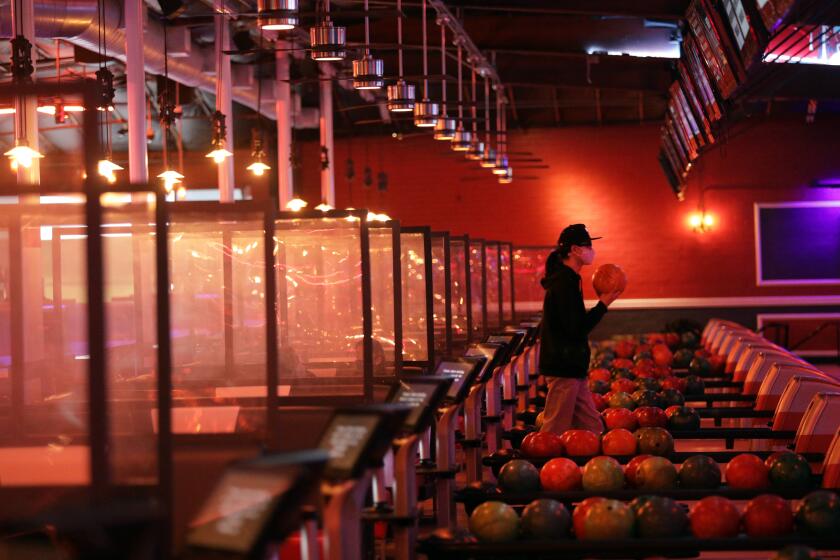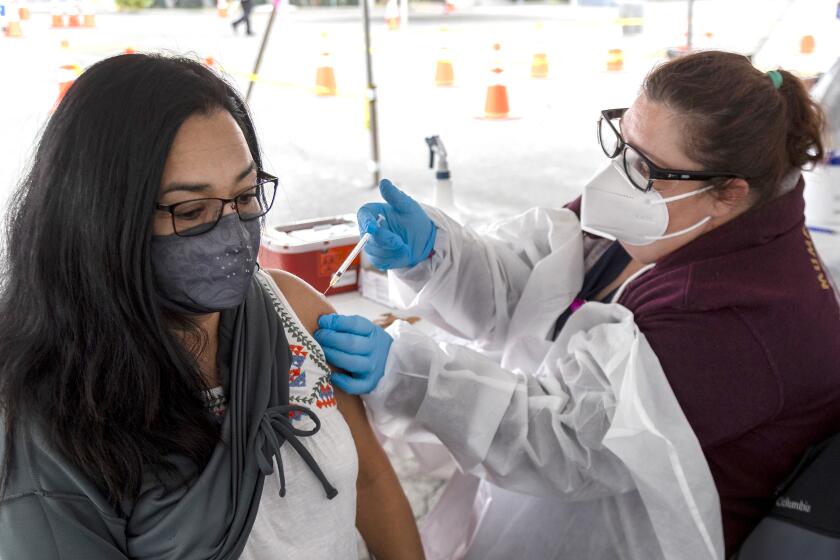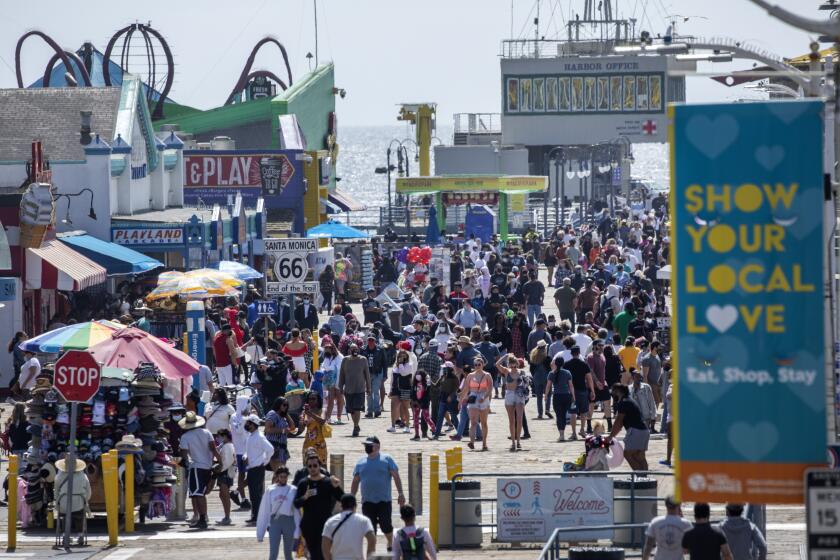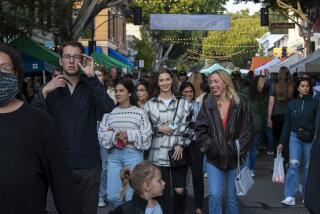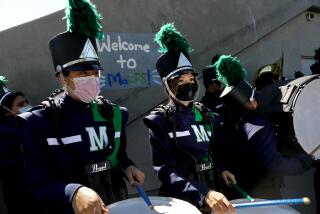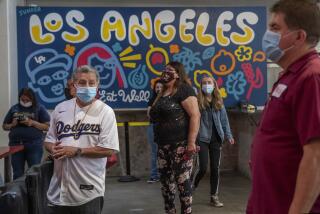A full reopening of California by June 15: Here’s what you need to know

California plans to lift most coronavirus restrictions on businesses and workplaces June 15. Officials say enough people should be vaccinated by then to allow life to approach a pre-pandemic normal.
After more than a year of coronavirus-related closures, California has a reopening date: June 15.
The target, announced Tuesday, is the clearest indication yet that the hard-hit state may be entering its final phase of the COVID-19 pandemic.
But amid the optimism, there are several variables at play.
Here are the basics:
What needs to happen?
Getting back to business as usual is dependent on two primary factors: a sufficient vaccine supply to inoculate all those who are eligible and willing, and stable and low numbers of people hospitalized with COVID-19.
State officials said they would track those issues closely but didn’t disclose any benchmarks associated with achieving those goals.
California aims for a full reopening on June 15, depending on a sufficient vaccine supply and a stable, low hospitalization rate, and masks.
Should trends continue to the state’s satisfaction, June 15 would mark the end of California’s current reopening road map, which sorts counties into one of four color-coded tiers based on three metrics: coronavirus case rates, adjusted based on the number of tests performed; the rate of positive test results; and a health-equity metric intended to ensure that the positive test rate in poorer communities is not significantly higher than the county’s overall figure.
Should any problems emerge in the coming weeks, however, it’s possible the state could push the date back.
“We’re always going to be led by data, led by reality and the lived experience on the ground,” said Gov. Gavin Newsom. “But our expectation is — if we’re vigilant, if we don’t spike the ball, if we don’t announce mission accomplished, and continue to do the good work that we’ve done — that by June 15 we’ll be beyond that blueprint and we’ll be back to a sense of normalcy.”
The move will make COVID-19 vaccines available to hundreds of thousands of additional Californians in counties across the state.
What would the reopening look like?
In a statement, officials said business sectors included in the state’s reopening blueprint would be allowed to “return to usual operations in compliance with Cal/OSHA requirements and with common-sense public health policies in place, such as required masking, testing and with vaccinations encouraged. Large-scale indoor events, such as conventions, will be allowed to occur with testing or vaccination verification requirements.”
The state added:
- Schools and institutions of higher education should conduct full-time, in-person instruction, in compliance with Cal/OSHA emergency temporary standards and public health guidelines.
- Workplaces should promote policies that reduce risk, including improved indoor ventilation, mask-wearing in indoor and other high-risk settings, and remote work when possible without affecting business operations.
- Travelers will be subject to any current restrictions outlined by the California Department of Public Health and U.S. Centers for Disease Control and Prevention.
- Unless testing or vaccination status is verified for all attendees, conventions will be capped at 5,000 people until Oct. 1.
- International convention attendees will only be allowed if fully vaccinated.
As California reopens further, wariness remains more than a year since the COVID-19 pandemic began. Residents wonder: Is it too soon to return to normality?
What about masks?
California’s mask mandate will remain in place for the foreseeable future. Other social distancing measures will also remain place, and that will affect the capacity limits of retailers, institutions and venues.
“We’re not anticipating, in the short run, lifting the mandate for masks,” Newsom said Tuesday. “We think it’s incredibly important. It’s the most powerful and important non-pharmaceutical intervention we can do to mitigate the spread of this disease.”
Along with encouraging all Californians to get vaccinated and mandating masking, officials say the state will continue testing and performing contact tracing to detect infections and help contain the coronavirus’ spread.
What if the numbers go up?
Officials said they wouldn’t hesitate to scale back reopenings if there was another surge.
“If we see any concerning rise in our hospitalizations, we will take the necessary precautions. But right now, we are hopeful in what we’re seeing as we continue to build on the 20 million vaccines already administered,” Dr. Mark Ghaly, California’s Health and Human Services secretary, said in a call with reporters.
So far, California’s coronavirus metrics are continuing to trend in the right direction, even as other states have seen spikes in recent weeks.
On Monday, 1,989 COVID-19 patients were hospitalized in California — with 493 of them in intensive care. The state hasn’t seen numbers that low since last spring.
Will there be enough vaccine to go around?
Officials hope so.
“With the expectation of an abundance of doses coming in from the federal government through the end of this month and into May,” Newsom said, “we can confidently say by June 15 that we can start to open up as business as usual — subject to ongoing mask wearing and ongoing vigilance.”
To date, providers throughout California have doled out 20.3 million total COVID-19 vaccine doses, and 34.2% of residents have received at least one shot, according to data from the Centers for Disease Control and Prevention.
Roughly 18.1% of Californians are fully vaccinated at this point, meaning they’ve either received the single-shot Johnson & Johnson vaccine or both required doses of the Pfizer-BioNTech or Moderna vaccine.
Nationwide, 32.4% of Americans have received at least one dose, and 18.8% are fully vaccinated, CDC data show.
During the early phases of the vaccine rollout, California restricted access to the shots to those considered at highest risk from COVID-19, either because of their age, occupation or underlying health conditions.
That will change starting April 15, when anyone 16 and older will be able to book appointments.
The state had widened vaccine eligibility last week to include everyone 50 and older.
President Biden had initially said states should make all adults eligible for COVID-19 vaccines by May 1. But he is expected to announce a more aggressive timeline Tuesday — setting a new deadline of April 19.
More to Read
Sign up for Essential California
The most important California stories and recommendations in your inbox every morning.
You may occasionally receive promotional content from the Los Angeles Times.
